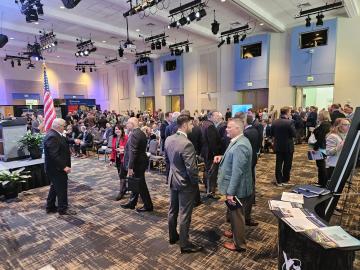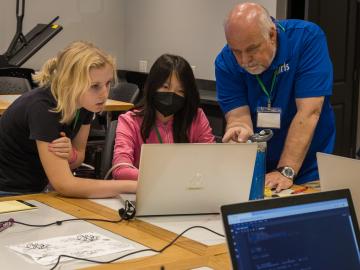
Filter News
Area of Research
- Advanced Manufacturing (2)
- Biology and Environment (22)
- Computational Biology (1)
- Computational Engineering (3)
- Computer Science (7)
- Electricity and Smart Grid (1)
- Energy Frontier Research Centers (1)
- Energy Science (33)
- Functional Materials for Energy (1)
- Fusion and Fission (11)
- Fusion Energy (10)
- Isotopes (3)
- Materials (57)
- Materials for Computing (9)
- Mathematics (1)
- National Security (14)
- Neutron Science (69)
- Nuclear Science and Technology (8)
- Sensors and Controls (1)
- Supercomputing (38)
News Type
News Topics
- (-) Artificial Intelligence (62)
- (-) Big Data (34)
- (-) Biomedical (32)
- (-) Clean Water (16)
- (-) Fusion (28)
- (-) Nanotechnology (44)
- (-) Neutron Science (88)
- (-) Security (13)
- 3-D Printing/Advanced Manufacturing (93)
- Advanced Reactors (27)
- Bioenergy (46)
- Biology (51)
- Biotechnology (16)
- Buildings (43)
- Chemical Sciences (57)
- Composites (25)
- Computer Science (121)
- Coronavirus (28)
- Critical Materials (23)
- Cybersecurity (21)
- Education (3)
- Element Discovery (1)
- Emergency (2)
- Energy Storage (80)
- Environment (99)
- Exascale Computing (24)
- Fossil Energy (2)
- Frontier (25)
- Grid (43)
- High-Performance Computing (58)
- Hydropower (6)
- Irradiation (3)
- Isotopes (29)
- ITER (6)
- Machine Learning (31)
- Materials (107)
- Materials Science (94)
- Mathematics (3)
- Mercury (5)
- Microelectronics (1)
- Microscopy (31)
- Molten Salt (8)
- National Security (26)
- Nuclear Energy (55)
- Partnerships (36)
- Physics (31)
- Polymers (24)
- Quantum Computing (21)
- Quantum Science (46)
- Simulation (24)
- Software (1)
- Space Exploration (13)
- Statistics (2)
- Summit (32)
- Transportation (73)
Media Contacts

Researchers at Oak Ridge National Laboratory have developed free data sets to estimate how much energy any building in the contiguous U.S. will use in 2100. These data sets provide planners a way to anticipate future energy needs as the climate changes.

Vanderbilt University and ORNL announced a partnership to develop training, testing and evaluation methods that will accelerate the Department of Defense’s adoption of AI-based systems in operational environments.

Scientists at ORNL completed a study of how well vegetation survived extreme heat events in both urban and rural communities across the country in recent years. The analysis informs pathways for climate mitigation, including ways to reduce the effect of urban heat islands.

Groundwater withdrawals are expected to peak in about one-third of the world’s basins by 2050, potentially triggering significant trade and agriculture shifts, a new analysis finds.

Thomas Proffen, a neutron scattering scientist at ORNL and founder of Oak Ridge Computer Science Girls, was recognized with an award from the National Center for Women & Information Technology, or NCWIT. In addition, one of his students received a national honor from the organization.

Rigoberto “Gobet” Advincula, a scientist with joint appointments at ORNL and the University of Tennessee, has been named a Fellow of the American Institute for Medical and Biological Engineering.

An international team using neutrons set the first benchmark (one nanosecond) for a polymer-electrolyte and lithium-salt mixture. Findings could produce safer, more powerful lithium batteries.
The Neutron Scattering Society of America, or NSSA, recognized Oak Ridge National Laboratory’s Ke An and Ken Herwig as fellows for their outstanding contributions to neutron scattering.

Jens Dilling has been named associate laboratory director for the Neutron Sciences Directorate at the Department of Energy’s Oak Ridge National Laboratory, effective April 1.
The United States could triple its current bioeconomy by producing more than 1 billion tons per year of plant-based biomass for renewable fuels, while meeting projected demands for food, feed, fiber, conventional forest products and exports, according to the DOE’s latest Billion-Ton Report led by ORNL.


